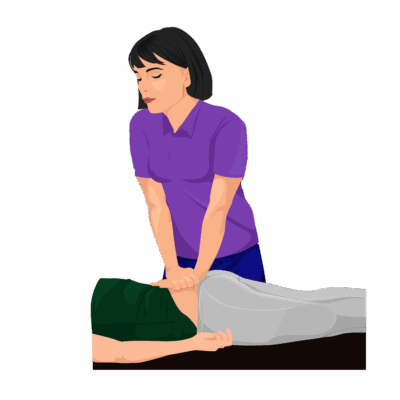Sacral Thrust Test
The Sacral Thrust Test is an orthopedic provocation maneuver used to assess sacroiliac joint (SIJ) dysfunction or pain. This test is commonly used as part of a cluster of SIJ provocation tests, helping to diagnose whether the SIJ is a likely contributor to low back or buttock pain.
How the Test is Performed
-
Client position: Prone (lying face down) on the treatment table.
-
The examiner stands to one side and places the heel/base of one hand over the midline of the sacrum (usually at S2), fingers pointing toward the client’s head.
-
A posterior-to-anterior force is quickly or gradually applied, pushing straight down through the sacrum, creating an anterior shear force at both SI joints.
-
The maneuver may involve a steady pressure for up to 30 seconds, or 3–6 gentle but firm thrusts.
-
A positive test: Reproduction of the client’s familiar pain in the region of one or both SIJs.
Clinical Significance
-
Positive Sacral Thrust Test indicates likely SIJ dysfunction, sprain, or primary pain, especially when pain is located at or near the SIJ.
-
Sensitivity (~63%) and specificity (~75%) are moderate when used alone, but diagnostic value increases significantly when combined with at least two other positive SIJ provocation tests (e.g., thigh thrust, FABER, compression, Gaenslen).
-
Use of a test cluster is strongly recommended for reliable SIJ diagnosis.
Assessment
-
Use Sacral Thrust as part of an SIJ assessment when clients present with chronic low back or buttock pain, particularly when other orthopedic and neurological causes have been ruled out.
-
Note which side symptoms are provoked, quality and intensity of pain, and use this info for treatment planning and multidisciplinary communication.
Treatment
-
If positive:
-
Avoid aggressive deep tissue, joint mobilization, or direct high-velocity force over the SIJ.
-
Focus on gentle soft tissue therapy for gluteals, lumbar, and pelvic stabilizers, myofascial release, and strategies to relieve compensation.
-
Educate clients on proper body mechanics, SIJ protection techniques, and activity modification to prevent aggravation.
-
-
Combine soft tissue work with exercise-based pelvic stabilization and stretching for adjacent muscles as appropriate, in collaboration with physiotherapists as needed.
Safety and Referral
-
Refer for further evaluation if there are red flag symptoms (neurological signs, severe/progressive pain, inability to weight bear) or if SIJ pain is persistent despite conservative therapy.
-
Use clusters of SIJ tests and clinical history, not the sacral thrust test alone, to support diagnosis and interdisciplinary referrals.

